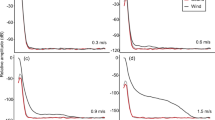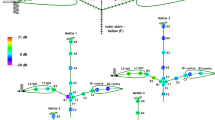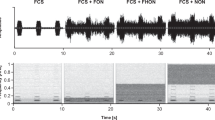Abstract
Noise that masks communication signals can affect the evolution of signal form and decisions about when and where to communicate. For the many invertebrates that communicate using plant-borne vibrations, wind is considered to be the major source of environmental noise. However, the influence of wind-induced vibrations on signaling behavior has not been experimentally tested. We tested the hypothesis that wind-induced noise influences signaling behavior in a plant-feeding insect (the treehopper, Enchenopa binotata ‘Ptelea’) in which mating is preceded by a vibrational duet between females and mate-searching males. We first characterized the diel signaling patterns of males in the field to identify the wind conditions under which signaling typically takes place. We then experimentally tested two predictions of the hypothesis: (1) that males use gap detection to initiate signaling during relatively wind-free periods; and (2) that females respond less to signals given in the presence of wind-induced vibrations. Both predictions were met, indicating that wind-induced noise is an important influence on the behavior of insects that use plant-borne vibrations.







Similar content being viewed by others
References
Andersson S, Rydell J, Svensson MGE (1998) Light, predation and the lekking behaviour of the ghost swift Hepialus humuli (L.) (Lepidoptera: Hepialidae). Proc R Soc Lond B Biol Sci 264:1345–1351
Atema J (1995) Chemical signals in the marine environment: dispersal, detection, and temporal signal analysis. Proc Natl Acad Sci USA 92:62–66
Aubin T, Jouventin P (1998) Cocktail-party effect in king penguin colonies. Proc R Soc Lond B Biol Sci 265:1665–1673
Barth FG (1988) Spiders of the genus Cupiennius Simon 1891 (Araneae, Ctenidae) II. On the vibratory environment of a wandering spider. Oecologia 77:194–201
Bee MA (2008) Finding a mate at a cocktail party: spatial release from masking improves acoustic mate recognition in grey treefrogs. Anim Behav 75:1781–1791
Brenowitz EA (1986) Environmental influences on acoustic and electrical animal communication. Brain Behav Evol 28:32–42
Brown TJ, Handford P (2003) Why birds sing at dawn: the role of consistent song transmission. Ibis 145:120–129
Brumm H, Slabbekoorn H (2005) Acoustic communication in noise. Adv Study Behav 35:151–209
Buus S (1985) Release from masking caused by envelope fluctuations. J Acoust Soc Am 78:1958–65
Casas J, Bacher S, Tautz J, Meyhöfer R, Pierre D (1998) Leaf vibrations and air movements in a leafminer-parasitoid system. Biol Control 11:147–153
Cocroft RB, Rodríguez RL (2005) The behavioral ecology of insect vibrational communication. Bioscience 55:323–334
Cocroft RB, Rodríguez RL, Hunt RE (2008) Host shifts, the evolution of communication, and speciation in the Enchenopa binotata species complex of treehoppers. In: Tilmon KJ (ed) Specialization, speciation, and radiation: the evolutionary biology of herbivorous insects. University of California Press, Berkeley, CA, pp 88–100
Cocroft RB, RodrÍguez RL, Hunt RE (2010) Host shifts and signal divergence: mating signals covary with host use in a complex of specialized plant-feeding insects. Biol J Linn Soc 99:60–72
Cokl A, Doberlet MV (2003) Communication with substrate-borne signals in small plant-dwelling insects. Annu Rev Entomol 48:29–50
Douglas HD III, Conner WE (1999) Is there a sound reception window in coastal environments? Evidence from shorebird communication systems. Naturwissenschaften 86:228–230
Endler JA (1993) The color of light in forests and its implications. Ecol Monogr 63:1–27
Fisher HS, Wong BBM, Rosenthal GG (2005) Alteration of the chemical environment disrupts communication in a freshwater fish. Proc R Soc Lond B Biol Sci 273:1187–1193
Foote AD, Osborne RW, Hoezel AR (2004) Whale-call response to masking boat noise. Nature 428:910
Forrest TG (1994) From sender to receiver: propagation and environmental effects on acoustic signals. Am Zool 34:644–654
Fuller RA, Warren PH, Gaston KJ (2007) Daytime noise predicts nocturnal singing in urban robins. Biol Lett 3:368–370
Gerhardt HC, Klump GM (1987) Masking of acoustic signals by the chorus background noise in the green tree frog: a limitation on mate choice. Anim Behav 36:1247–1249
Greenfield MD (1988) Interspecific acoustic interactions among katydids Neoconocephalus: inhibition-induced shifts in diel periodicity. Anim Behav 36:684–695
Greenfield MD (1994) Synchronous and alternating choruses in insects and anurans: common mechanisms and diverse functions. Am Zool 34:605–615
Hopkins CD (1973) Lightning as background noise for communication among electric fish. Nature 242:268–270
Hunt RE (1994) Vibrational signals associated with mating behavior in the treehopper, Enchenopa binotata Say (Hemiptera: Homoptera: Membracidae. J N Y Entomol Soc 102:266–270
Hunt RE, Morton TL (2001) Regulation of chorusing in the vibrational communication system of the leafhopper Graminella nigrifons. Am Zool 41:1222–1228
Lengagne T, Slater PJB (2002) The effects of rain on acoustic communication: tawny owls have good reason for calling less in wet weather. Proc R Soc Lond B Biol Sci 269:2121–2125
McNett GD, Cocroft RB (2008) Host shifts favor vibrational signal divergence in Enchenopa binotata treehoppers. Behav Ecol 19:650–656
Michelsen A, Fink F, Gogala M, Traue D (1982) Plants as transmission channels for insect vibrational songs. Behav Ecol Sociobiol 11:269–281
Okanoya K, Dooling RJ (1990) Detection of gaps in noise by budgerigars (Melopsittacus undulatus) and zebra finches (Peophila guttata). Hear Res 50:185–192
Ord TJ, Peters RA, Clucas B, Stamps JA (2007) Lizards speed up visual displays in noisy motion habitats. Proc R Soc Lond B Biol Sci 274:1057–1062
Parris KM, Velik-Lord M, North JMA (2009) Frogs call at a higher pitch in traffic noise. Ecol Soc 14:25
Patricelli GL, Blickley JL (2006) Avian communication in urban noise: causes and consequences of vocal adjustment. Auk 123:639–649
Polajnar J, Čokl A (2008) The effect of vibratory disturbance on sexual behaviour of the southern green stink bug Nezara viridula (Heteroptera, Pentatomidae). Cent Eur J Biol 3:189–197
Rodríguez RL, Cocroft RB (2006) Divergence in female duetting signals in the Enchenopa binotata species complex of treehoppers (Hemiptera: Membracidae). Ethology 112:1231–1238
Rodriguez RL, Ramaswamy K, Cocroft RB (2006) Evidence that female preferences have shaped male signal evolution in a clade of specialized plant-feeding insects. Proc R Soc Lond B Biol Sci 273:2585–2593
Römer H (1993) Environmental and biological constraints for the evolution of long-range signalling and hearing in acoustic insects. Philos Trans R Soc Lond B Biol Sci 340:179–185
Ryan MJ, Brenowitz EA (1985) The role of body size, phylogeny, and ambient noise in the evolution of bird song. Am Nat 126:87–100
Saxena KN, Kumar H (1980) Interruption of acoustic communication and mating in a leafhopper and a planthopper by aerial sound vibrations picked up by plants. Experientia 36:933–936
Schneider BA, Pichora-Fuller MK (1994) Gap detection and the precedence effect in young and old adults. J Acoust Soc Am 95:980–991
Schwartz JJ, Gerhardt HC (1989) Spatially mediated release from auditory masking in an anuran amphibian. J Comp Physiol A Sens Neural Behav Physiol 166:37–41
Schwartz JJ, Wells KD (1983) The influence of background noise on the behavior of a Neotropical treefrog, Hyla ebraccata. Herpetologica 39:121–129
Seehausen O, Alphen JJMv, Witte F (1997) Cichled fish diversity threatened by eutrophication that curbs sexual selection. Science 277:1808–1811
Slabbekoorn H, Peet M (2003) Birds sing at a higher pitch in urban noise. Nature 424:267
Slabbekoorn H, Ripmeester EAP (2008) Birdsong and anthropogenic noise: implications and applications for conservation. Mol Ecol 17:72–83
Slabbekoorn H, Smith TB (2002) Bird song, ecology and speciation. Philos Trans R Soc Lond B Biol Sci 357:493–503
Sullivan Beckers LE (2008) The ecology of mate choice: identifying the agents of sexual selection on mating signals in Enchenopa treehoppers. University of Missouri, Dissertation
Sun JWC, Narins PM (2005) Anthropogenic sounds differentially affect amphibian call rate. Biol Conserv 121:419–427
Tishechkin DY (2007) Background noises in vibratory communication channels of Homoptera (Cicadinea and Psyllinea). Russ Entomol J 16:39–46
Waser PM, Waser MS (1977) Experimental studies of primate vocalization: specializations for long-distance propagation. Z Tierpsychol 43:239–263
Wiley RH, Richards DS (1982) Adaptations for acoustic communication in birds: sound transmission and signal detection. In: Kroodsma DE, Miller EH (eds) Acoustic communication in birds, vol I, Academic Press. New York, NY, pp 131–181
Acknowledgements
We thank C. Galen, C. Gerhardt, R. Houseman, J. Schul, and three anonymous reviewers for comments on the manuscript. This research was supported by NSF IBN 0318326 to RBC and NSF DDIG IOB 0508642 to RBC and GDM.
Author information
Authors and Affiliations
Corresponding author
Additional information
Communicated by D. Gwynne
Rights and permissions
About this article
Cite this article
McNett, G.D., Luan, L.H. & Cocroft, R.B. Wind-induced noise alters signaler and receiver behavior in vibrational communication. Behav Ecol Sociobiol 64, 2043–2051 (2010). https://doi.org/10.1007/s00265-010-1018-9
Received:
Revised:
Accepted:
Published:
Issue Date:
DOI: https://doi.org/10.1007/s00265-010-1018-9




